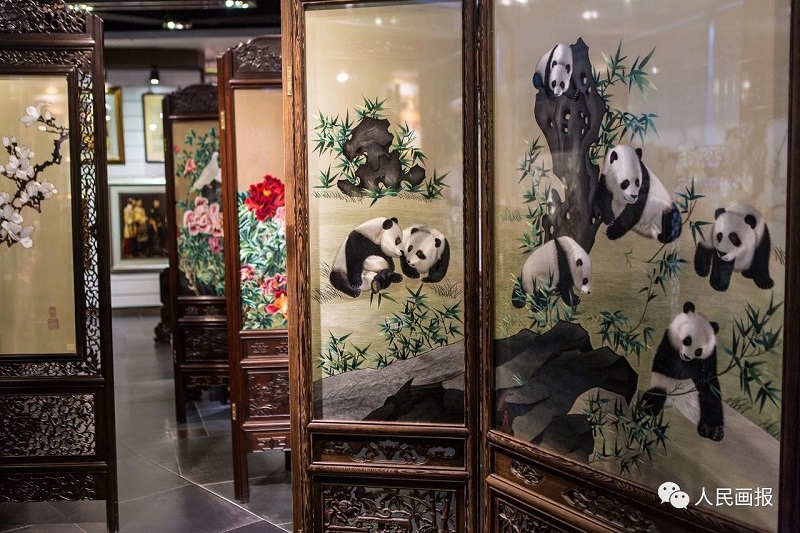Chengdu: Where Phoenixes Soar

When Chengdu is mentioned, its hot pot and pandas instantly spring to many minds. However, as a city with over 3,000 years of rich history, Chengdu has much more to offer. After visiting the Giant Panda National Park and tasting the famous hot pot, visitors should venture deeper and discover places such as the Temple of Marquis Wu and the Thatched Cottage of Du Fu. If they venture a little deeper still, the gateway to a realm of poetry awaits.

Museum. (Photo courtesy of Chengdu Wuhou Shrine Museum)
Like many other historical metropolises, Chengdu has also experienced its share of triumphs and losses, heroes and cowards, love and sorrows, evoking images of past riverine verandas and the lingering fragrance of plum blossoms. In this revered poetic place, it is easy to envision Lu You, a Chinese poet from the Southern Song Dynasty (1127-1279), strolling tipsily among rioting blossoms, or Du Fu, the sage poet of the Tang Dynasty (618-907), anxiously awaiting dawn after a night of spring rain, as he described in one of his poems: “Twilight illuminates the wet reds, and flowers cloak Brocade City.” And don’t forget Li Bai, a poet with celestial talent in the Tang Dynasty, whose exhilarating chants resounded from the lofty Flower Scattering Tower, where “its stairway leads into azure clouds where the distant view dissipates sorrow.”
The poetic tradition of Chengdu is rich and vibrant. I thought I knew a lot about Chengdu after translating over a hundred classic poems for the book titled Chengdu: The Land of Poetry and Abundance—One Hundred of the Most Beautiful Poems of Chengdu. However, my perspective shifted when I began translating The Compendium of Chengdu, one of the most important books about Chengdu from the late Qing Dynasty (1644-1911). It was like stepping into a time capsule from the late 1800s. Pushing open the creaking door of history, brushing away the dangling spider webs, and blowing off a thick layer of dust, I saw a different Chengdu—a less glamorous city filled with suffering and struggling with agony for change around the turn of the 20th century.
Historically, Chengdu owed its peace and abundance to two key factors. The first was the Dujiangyan Irrigation System built by Li Bing of the ancient Qin kingdom during the Warring States Period (475-221 BC). The irrigation system ensured a perpetual fragrance of bountiful rice permeating the vast Chengdu Plain, and the other was the Shu Pass of Jiange, an important passage in and out of the plain in ancient times. A well-known idiom perfectly captures its value: “A single soldier can guard the pass while a force of ten thousand strong laments.” While the strategic terrain helped protect the Chengdu Plain from external invasions in the past, it also limited access to the outside world. In the early 1900s, Chengdu had fallen far behind the coastal regions of China. Lawless warlords, bandits, persistent famine, and continuous waves of refugees plagued the once-prosperous land. Its economy eventually became weak and malnourished. Local entrepreneurs and domestic workshops, if any, were ruthlessly crushed by an overwhelming influx of foreign goods arriving through the ports of southern China’s Guangdong Province.
Change was necessary, and the resilient people of Chengdu again demonstrated their perseverance and tenacity. Instead of remaining idle or migrating elsewhere, they organized one of the earliest promotional markets for local goods in China and various vocational training centers aiming to protect and promote products made in Sichuan. And Chengdu took a broader approach by training the unemployed to be self-reliant.

Chengdu’s economy took off in the 1970s. After over four decades of development, the city emerged as an economic hub in southwestern China, with a population exceeding 20 million people. No longer held back by its location, geography is what makes Chengdu such an important hub of China’s Belt and Road Initiative. Chengdu’s culture, practices, and way of life have garnered praise from around the world. For instance, an article from Chicago-based PR Newswire endorsed Chengdu’s practice of sustainable development, while Hong Kong-based South China Morning Post named Chengdu one of the most fashionable cities. The Daily Telegraph of Britain even published an article titled “Chengdu: Discover a City Chock-full of Culture.”

With interconnected zero-carbon concept parks and recreational areas stretching for miles, Chengdu has consistently been named one of the happiest cities in the world. Since 2018, more than 20,000 China-Europe freight trains carrying various goods and products have traveled between Chengdu and Europe. Now, with trains connecting to Laos as well, Chengdu is rapidly emerging as a new center for trade with Southeast Asian nations. From its desperate attempt to establish a promotional market for local goods and vocational training centers in the late 1800s, Chengdu has come a long way to reclaim its former glory.

Chengdu City embodies the Eastern philosophy of “learning from nature” and
integrates with its surrounding elements harmoniously. (Photo courtesy of Zhi Art
Museum)
This is a new Tale of Two Cities, with phoenixes soaring above China’s southwest. The legendary birds obtain new life by rising from the ashes of their predecessors. Since ancient times, they have been believed to descend and gracefully dance as a symbol of auspiciousness in China. The trees on which they tend to nestle and perch are therefore called phoenix trees, known for their vigorous growth. A line from the earliest collection of Chinese poems The Book of Songs goes: “The phoenix calls from the ridge yonder. Lush phoenix trees thrive, facing the rising sun.” It is fitting that Chengdu has a mountain shaped like a phoenix spreading its wings, with numerous phoenix trees atop it.
The author is a research fellow and high-end foreign expert at Chengdu University, and former director of the Confucius Institute of the University of New Hampshire.